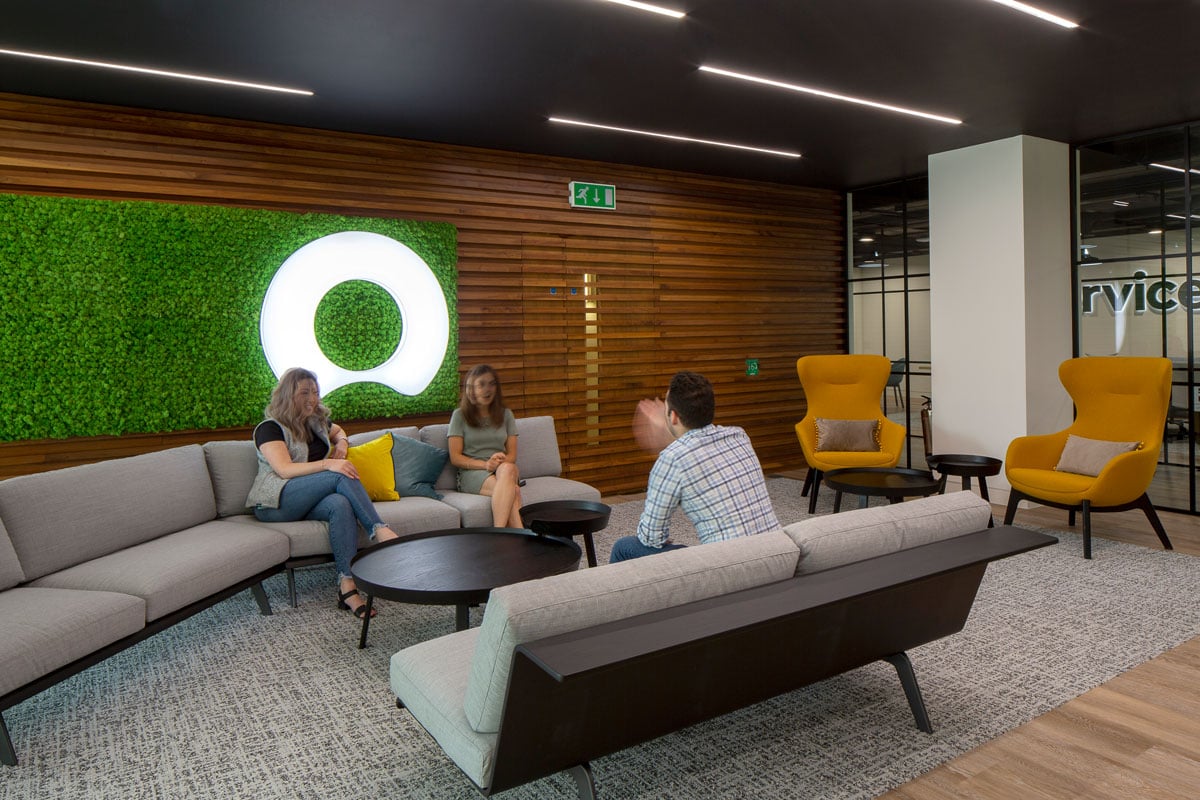Creativity is the most valuable currency in the global economy today. It is the means by which companies differentiate their commercial offerings and themselves in a crowded and hyper-competitive marketplace.
Creative currency drives commerce
In the modern world, creativity has become productivity. In the age of disruption, the ability for organisations to continually innovate around (and reinvent) their product suite is critical to their growth and survival.
What's more, creative employees are not only more effective workers, but they also tend to be happier people. And when workers are happier and more engaged, they stay at a company for longer.
When nothing stands still
Disruption is affecting everyone. Traditional business models are being rendered obsolete as new technology presents novel ways to serve customers and solve for their problems. Hyperscale challengers are exploiting opportunities in various sectors, thanks to their big data advantage and, crucially, the creative confidence of the talent they employ.
Faced with this reality, companies of all kinds are realising their competitive advantage must lie in the people whose ideas drive them forward - the creative minds that can apply themselves to understanding and solving for the needs of their customers.
As one KPMG report puts it:
"Disruption acts as a driver of change across many business disciplines. Its effects are pervasive, requiring firms to invest differently, act bravely and adapt their corporate cultures."
Knowledge sharing and organisational transparency as creative drivers
The most progressive companies are listening to ideas from wherever they emerge in their business, adopting a culture of knowledge sharing across departments - ensuring the talents and visions of a new generation of workers are respected and cultivated.
Because creativity isn’t about one individual in an organisation anymore - an Ogilvy-like figure ruling the roost, from whom all ideas emanate and where all initiatives are ultimately sanctioned.
The agile workforce collaborates to ideate and deliver quickly and as one, identifying needs, failing fast and succeeding quickly.
The great leaders of today realise that everyone in a company can and must contribute to a culture of continuous creative innovation if they are to respond to the shifting challenges of 21st Century business.
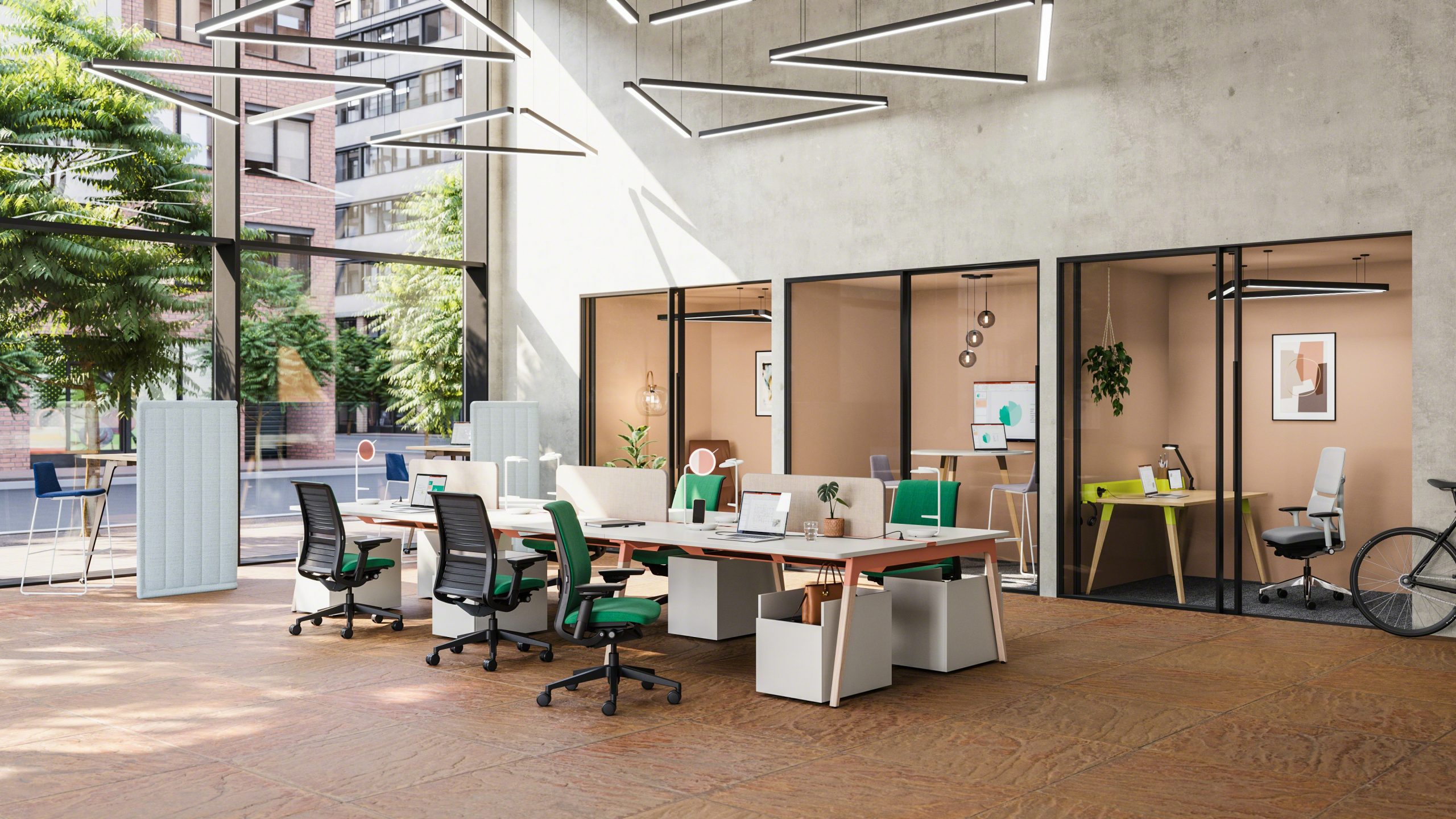
The state of creativity
With all this in mind it should come as no surprise that Steelcase research found that 72% of people at work today believe their future success depends on their ability to be creative. And yet the same research points to a consistent failure of employers to provide the right conditions for creativity to thrive.
The research shows the kind of roadblocks that many workers feel are standing in the way of reaching their full creative potential.
In the Steelcase study 20% of the 4,500 participants cited uninspiring spaces as a major block on their creativity within the workspace; 20% identified outdated technology as a factor, 36% blamed the weight of their existing workloads, while 19% thought they lacked the guidance and permission to be creative.
Holistic design response
So when companies are responding to the need to stimulate creativity in the workplace, the findings are that the challenge is holistic.
Nearly every part of the working day is a creative undertaking, after all. From the problem-solving ‘stand up’ sessions that set the daily agenda for a team, to the agile planning sessions that bring disciplines together to collaborate on strategic solutions.
Biz dev, account management, design and dev roles are all defined by the need to innovate and reinvent - to co-operatively solve for the challenges presented by evolving technology, platforms and channels.
And what’s more, the roles and responsibilities (previously clearly demarked and siloed) are becoming increasingly porous.
Because of all this, the workspace design response has to be equally flexible and reflective of blurring boundaries between disciplines.
It must also be mindful of the possibility of inspirational work occurring anywhere within a workspace both formally and informally - and of the shift towards hybrid work, where the workforce can be split between the office, home and the third place at any given time.
“Creativity isn’t a linear process. It’s not even a predictable process. It has a rhythm of different activities and requires both convergent and divergent thinking.”
- James Ludwig, Vice President, Global Design, Steelcase
Creativity in the hybrid workplace
So, creativity is key to a company’s success. But what happens when workers are no longer physically together eight hours a day, five days a week?
The shift to hybrid work means fewer ‘water cooler’ interactions and meetings with everyone present in person. Surely this can’t be good for creativity?
According to HBR, hybrid work can endanger two types of creativity: collective and individual.
“Perhaps the most obvious one is collective creativity: people can brainstorm via zoom, but programmed times and formats for generating ideas may well not prove as fruitful as the more fluid conversations, sidebars, and unexpected things that can happen when we kick ideas around with others or work intensively on solving a problem together.
But individual creativity can be endangered, too. We know that quiet time alone can help people generate novel ideas and insights. Yet it isn’t clear that working alone over many days or weeks will prove generative for employees who must be constantly creative or innovative.”
But maybe hybrid work isn’t a threat to creativity. Maybe it’s an opportunity. Maybe by embracing the flexibility of hybrid working, employers are actually laying the foundations for more creativity.
If employees have more freedom over where, how and when they work, it reduces stress, boosts happiness, and enables creative juices to flow.
Another upside of hybrid work is it allows companies to tap into a more diverse workforce. Diverse teams tend to be more creative because they are exposed to different attitudes and means of expression, creating an environment for novel ideas and innovation.
The creative opportunity of the workspace
From the moment we walk into the office, the quality of our focus and collaborative energy should be harnessed and optimised by our surroundings.
So, how can you design your workspace to support this creativity - and keep the people in your business engaged and contributing to its success and innovation in every way?
Creativity is a collective pursuit, but it is also strongly linked with a sense of shared personal and professional fulfilment.
Key ways to design for creativity in the workplace
1. Create environments that stimulate emotional connections
- Use ambient and thoughtful design elements to inspire thinking and foster team culture.
- Build a welcoming environment and personal connection to a space with authentic design elements, artefacts and materiality.
- Within meeting rooms and collaborative workspaces support a variety of posture options that allow for comfortable proximity to other people and content sources. Keep sightlines to screens open and make eye-to-eye contact possible for colleagues.
2. Build a fluid creative ecosystem
- A variety of spaces can support individuals and teams as they cycle through their days to day tasks and creative processes. Design for moments of individual exploration, cognitive resting, social connection, co-creation and evaluation.
- Build an ecosystem with options so people can choose where and how to work. A range of spaces and devices is necessary to support the diverse stages of creative work.
- Scale the ecosystem with separate spaces or zones for specific individual, team and organisational needs.
- In the natural ebb and flow of office life, there should always be the possibility of accidental encounters between disparate people that can identify opportunities or spark new ideas. Some offices are designed to achieve just this. Think of the UK TV HQ which uses communal space to connect workers in exactly this way:
“We wanted to disassemble the hierarchy through design. Partly we did that by redesigning our entire office. We assembled this huge stairway to connect the two floors as we don’t want our employees to be separated. We want them to connect and bump into each other. These serendipitous meetings create some of the best ideas"
Darren Childs, ex UKTV CEO
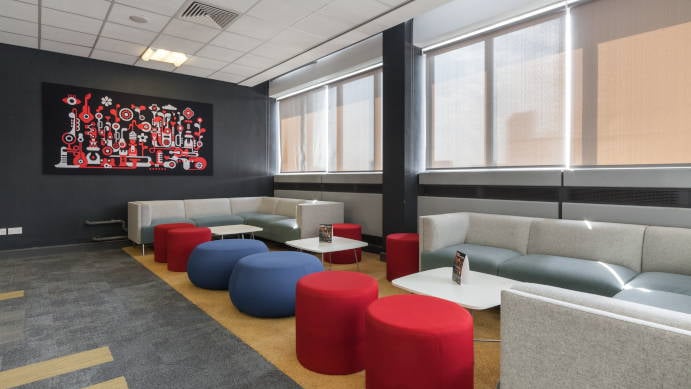
3. Nurture creative confidence
- Support the visibility and tangibility of ideas by using partitions and walls as postable, writing surfaces to guide the creative process.
- Provide co-creation tools, such as large-scale computing devices, that allow everyone to contribute to and interact with content. Does your workspace allow for the seamless sharing of content between devices and rooms?
- Make hybrid collaboration easier by using virtual whiteboards and brainstorming software to allow for equal participation beyond boundaries.
- Enable privacy and control over the environment to provide a “safe haven” where new ideas can incubate.
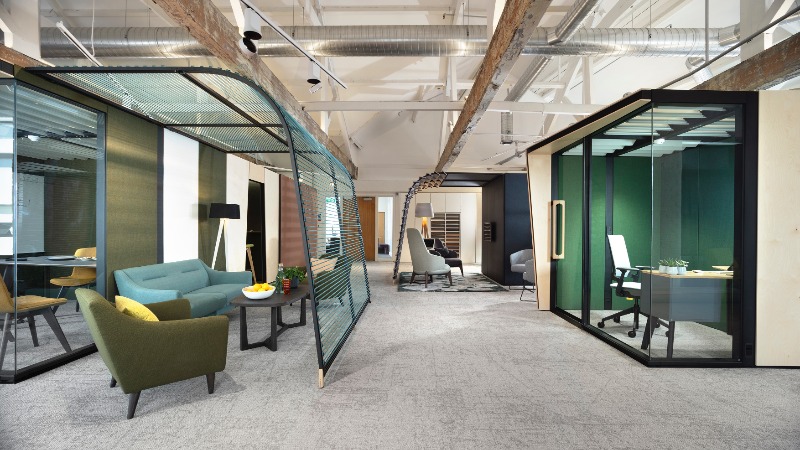
4. Allow workers to manipulate the workspace
- Flexibility at work helps creativity thrive. Moveable screens, whiteboards and barriers enable workers to ‘hack’ the space for productivity and creativity.
- Products like Flex Active Frames allow us to 'build' working neighbourhoods within larger spaces, where teams can create their own micro-spaces to support the working patterns that suit them best.
- Portable power packs let people work wherever they need to.
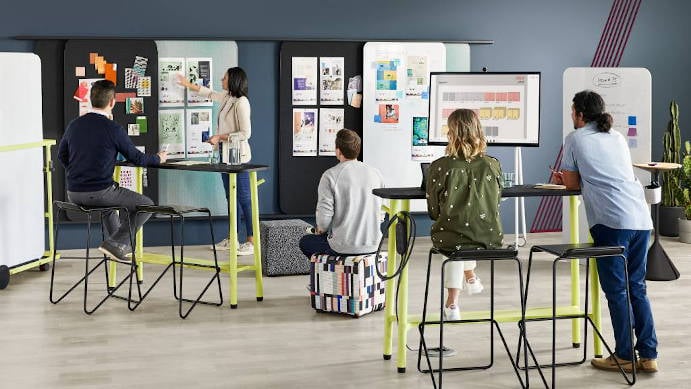
5. Enhance the hybrid collaboration experience
- Use multiple display screens (both fixed and mobile) within the space to maximise available angles and possibilities for presentations.
- A camera with auto-framing capabilities will allow remote participants to see the person speaking even if they move around.
- Within the room, use moveable tables to reposition for clear sight lines to people and content. They can be adjusted as the needs of the meeting change.
- Virtual whiteboards will enable equal participation amongst team members in brainstorming sessions.
- A mix of analog and digital displays make it easy for a team to pin and present ideas to team members.
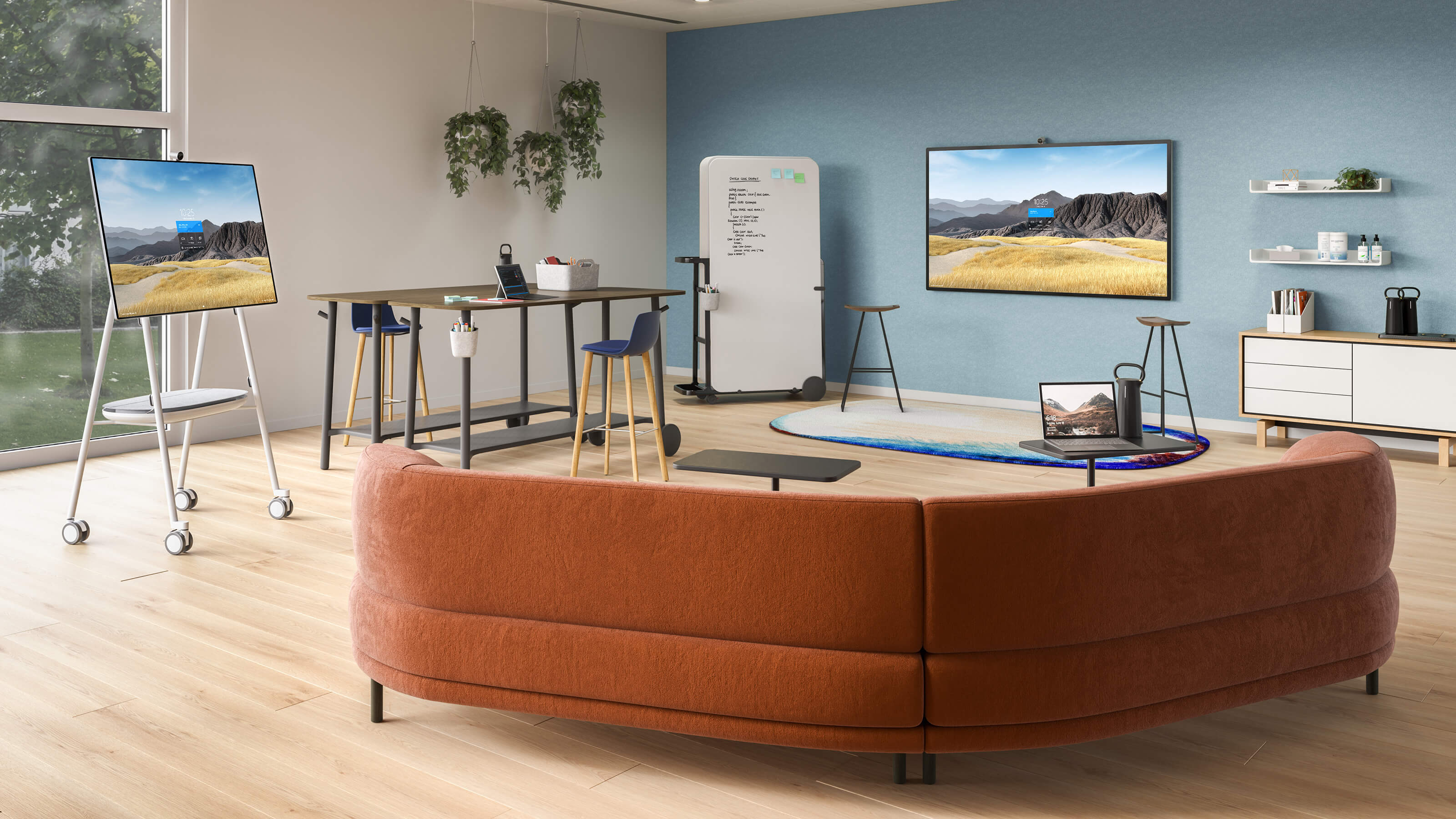
6. Provide space for time out
- Wellness rooms allow workers to step away for a mental health break, so they can come back refreshed and rejuvenated.
- Tech-free zones allow for creative thinking with no distractions.
- Furniture that supports lounging aids creative thinking while enabling workers to relax in readiness for collaboration sessions.
- Ambient lighting and imagery create a relaxed environment to enhance feelings of calm and relaxation so workers can come back ready to innovate.
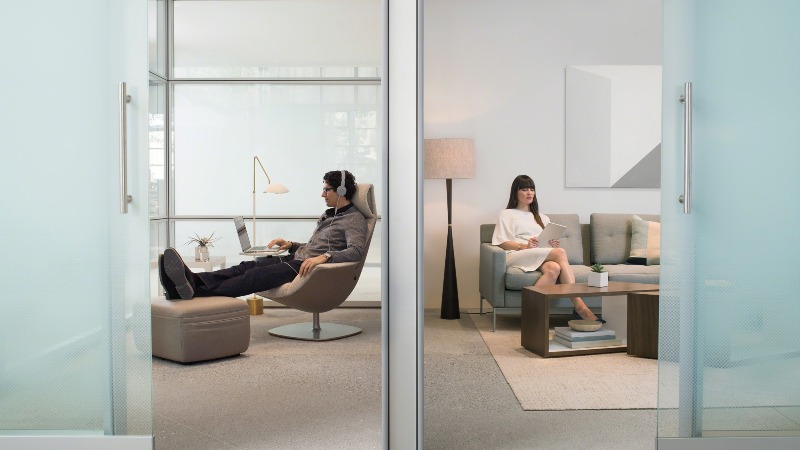
7. Design for inclusivity to attract diverse talent
- Make the space accessible; ensure corridors are wide enough for two passing wheelchairs, include multi-height surfaces in communal areas such as kitchens and toilets, and use door handles suitable for those with limited dexterity (e.g. levers instead of knobs).
- Incorporate green walls and natural elements such as timber wood, marble, granite and stone to help reduce stress levels and enhance aesthetics.
- Introduce apps that allow users to adjust their environment, for example, heating and lighting controls.
Summary
The modern workplace should optimise for creativity by facilitating comfort, collaboration and more meaningful interactions between people, content and technology.
In amongst these more practical considerations is the intriguing possibility of designing for creative serendipity - building workspaces that are so free of silos, so frictionless in their accommodation of networked teams that they can facilitate chance encounters and power new collaborative processes that lead to even greater organisational success.
Outside of the physical workspace, we can fuel creativity by enhancing the hybrid collaboration experience and focusing on attracting and retaining a diverse range of talent with broad experiences.







